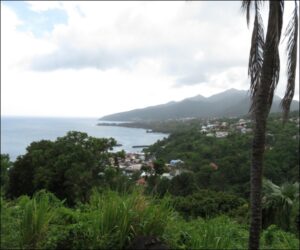The Niña and India were overloaded with Spanish passengers and Taíno slaves (as well as Chief Caonabó), and Columbus imposed tight rations from the moment they departed Isabela for Spain (see prior post). He set the caravels’ initial course toward islands he’d visited several years earlier on the outward leg of the second voyage, as they were the shortest landless distance from Spain he knew of, contemplating restocking provisions there before veering northeast to cross the ocean.
On April 10, 1496 (528 years ago), after bucking headwinds for a month, Columbus brought the ships to anchor off the black-sand beach of the island he’d named Guadalupe in November 1493, where on the outward voyage his men had abducted local Caribe and other peoples for enslavement in Spain (the beach at Grande Anse, Basse-Terre, Guadeloupe, the modern French spelling). For discussion of those events, see post of November 4, 2021, at andrewrowen.com/guadeloupe/ . The Kalinago or Caribe name for Basse-Terre, Guadeloupe, was Caloucaera, the Taíno name Turuqueria.
As depicted in Columbus and Caonabó, the women Caribes at the beach had ugly memories of Columbus’s past visit, brandished bows and arrows, and tricked him to debark elsewhere, where other Caribes attacked. Columbus dispatched armed men ashore to overpower and commandeer the nearest village. After a skirmish, the Taíno slaves aboard the caravels were ferried ashore and set to work in the Caribe village baking cassava with the Caribe villagers’ yucca crops and utensils. Columbus also dispatched a raiding party inland to seize a dozen Caribe women and boys, including a chieftain’s wife and daughter, to hold hostage aboard the Niña to forestall attack while the cassava was baked. Three weeks supply was baked in nine days.
On April 20, immediately prior to departure for Spain, Columbus conferred token gifts on the Caribe hostages and released all but the chieftain’s wife and daughter, whom he wanted to haul to display to Queen Isabella and King Ferdinand.
The photos below are of the black-sand beach from afar, closer, and then upon it.



